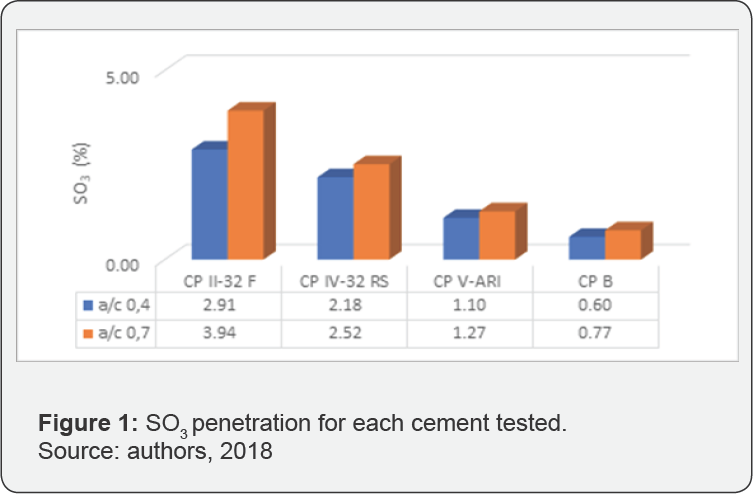Comparative Study of the Attack Magnesium Sulphate on Different Types of Portland Cement - Juniper publishers
Journal of Trends in Technical and Scientific Research
Introduction
Sulphate attack is one of the major threats to the durability of cementitious materials [1].
It comprises a series of chemical reactions between the sulfate ions
and the hardened cement paste, culminating in the formation of secondary
ettringite, causing the increase in the volume inside the concrete, the
formation of micro-cracks and the erosion of the concrete surface [2,3]. The most common sulfates involved in the deterioration of concrete structures are calcium sulfate (CaSO4), sodium sulfate (Na2SO4) and magnesium sulfate (MgSOJ [4].
Santhanan et al.[5]
present a good review on the attack of sulphates on cementitious
materials involving the attack mechanism, tests and modeling parameters.
A study on the durability of sulfate-exposed concretes was held by
Roziere et al [6]. Brown & Doerr [7]
studied the action of carbonation, the ingress of chlorides and the
action of calcium, sodium and magnesium sulphates. Uddin & Quayyum [8]
studied the action of calcium sulphate on mortars. The attack of cement
mortars by sodium and magnesium sulphates was studied by Santhanan et
al.[5,9] assessing different concentrations and temperatures.
The mechanisms of diffusion and migration of sodium and magnesium sulfates were studied by Lorente et al.[1]. Ouyang et al. [3]
assessing the changes in surface hardness of concrete submitted to
sulfate attack and verified the influence of water/ cement ratio and ion
concentration. The influence of the cement type on the sulfate attack
for the formation of taumasite was studied by Nobst & Stark [10] who verified the influence of C3A and the amount of Al2O3.
Magnesium sulphate is considered the most harmful and
was used as the object of this study, since it can react with all the
hydration products of the cement, forming ettringite and brucite
(Mg2SO4)[11].
This last precipitates and causes a decrease in the pH of the pore
solution, leading to the decalcification of the C-S-H phase, which is
responsible for the cement cohesion.
Considering the influence of the cement type and the
water/ cement ratio on the penetration of sulfate ions in the concrete,
the present study evaluated 4 differents Brazilian cements and two
water/cement ratios in test speciments submitted to magnesium sulphate[12].
Experimental Research
For the study were molded cylindrical specimens of
mortar with 5cm x 10cm, according to NBR 5738/2015, using the Brazilian
Portland cement CP 11-32 F, CP 1V-32 RS, CP V (ARI) and CP B (White),
whose chemical compositions are presented in Table 1. The natural sand with fineness modulus 2.45 was used for the molding of the specimens[13]. The mortar was produced with a 1: 3 composition in two water/cement ratios (w/c) of 0.40 and 0.70.

Source: Itamb�, 2018
The specimens were healed for 7 days and then
submitted to the attack process of magnesium sulphate in 10% of mass,
strength aqueous solution for a period of 11 weeks. The sulfate content
in each sample was then determined according to ASTM C 114-07 Standard
Test Method for Chemical Analysis of Hydraulic Cement[14].
The results are presented in Figure 1 and indicate the influence of the type of cement and the water/cement ratio on the penetration of magnesium sulphate[15,16].

In all cases, it was verified that the increase of
the water/ cement ratio leads to a higher sulphate penetration due to
the increased permeability of the concrete. As for the influence of the
cement type, it was verified that the CP IV and CP V-ARI cements had
lower sulphate amounts than the CP II F-32, showing their characteristic
of resistance to sulphates when compared to a cement in common use.
This characteristic occurs due to the low C3A content in these cements,
the fineness of these cements, whose specific surfaces are 4290m2/kg and 4078m2/kg,
and the additions of pozzolan and filer that make them less pores can
still be considered. The white cement (CP B) showed the lowest
penetration of sulphates, presenting a feature of resistance to
sulfates, keeping with its low C3A content.
To Know More About Trends in Technical and ScientificResearch click on: https://juniperpublishers.com/ttsr/index.php
To Know More About Open Access Journals Please click on:




Comments
Post a Comment